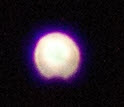I do not know. This year since 01-Jan-2020 through 20-April-2020, I viewed Venus 15x using my 90-mm refractor telescope and Newtonian 10-inch reflector. Venus never looks like your image in my eyepieces. At the beginning of this year Venus was near 13" angular size and now is more than 33" angular size, less area illuminated too. By the end of this month Venus will be 38" size and 26% illuminated area. Your image looks like the object is nearly 100% illuminated, minus the "bite". Venus ephemeris in Sky & Telescope monthly magazine, Starry Night, SkySafari, Stellarium software, will show the phase, size, and illumination of Venus when viewing as well as the planet's distance. My observations of Venus this year range from 31x to 200x views and with different filters too, sometimes cloud banding is slightly visible in the telescope view. This year Venus had close conjunctions with Neptune and Uranus, also M45 star cluster. Very enjoyable views of Venus passing near and through M45 star cluster as well as close to Uranus and Neptune.



